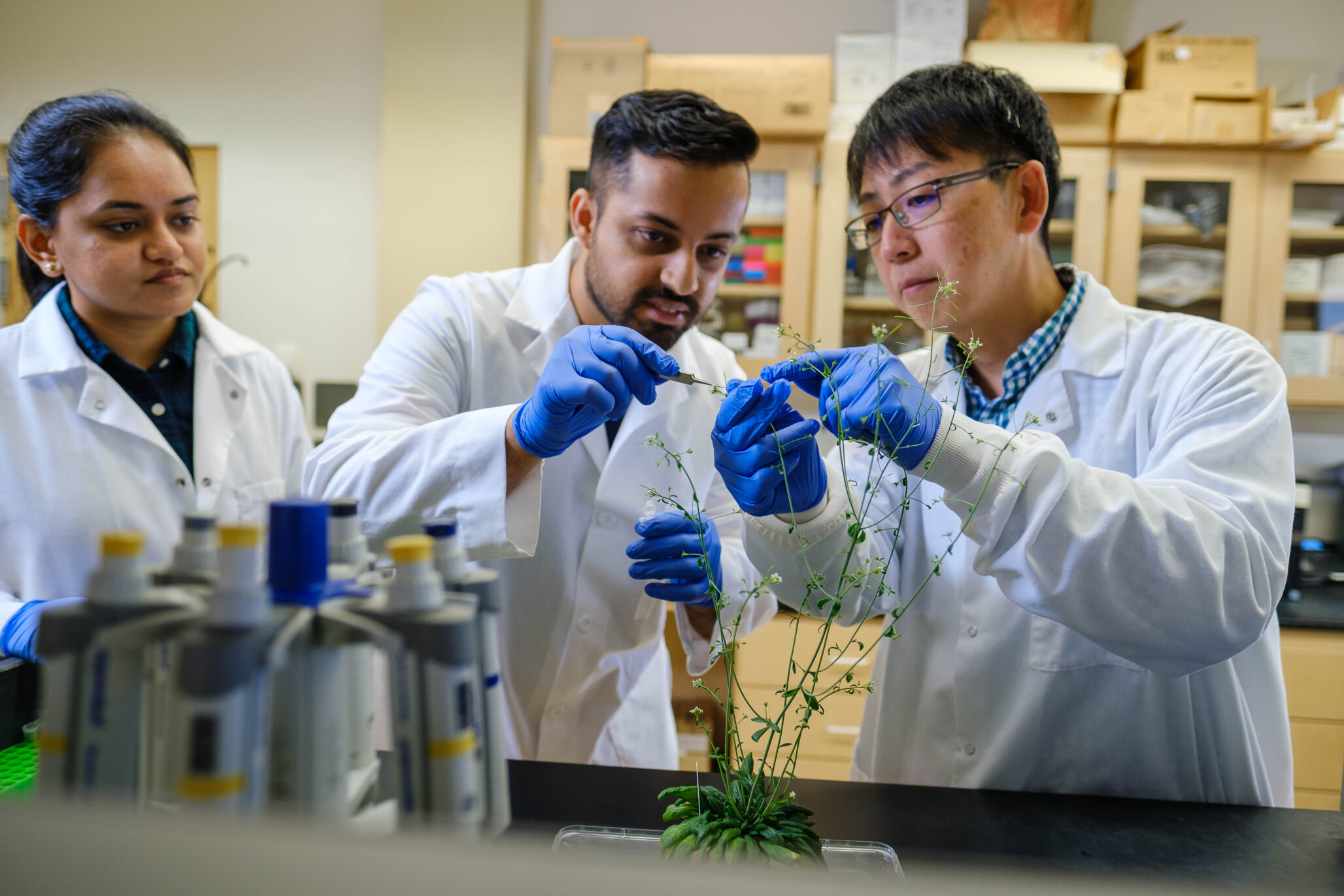Silenced genes could pose a significant obstacle in plant reproductive research.
In the quest to understand plant reproduction, scientists often turn to gene editing, introducing new genes (transgenes) into plants to study their effects. However, recent research revealed a puzzling phenomenon in the sperm cells of Arabidopsis thaliana, a model plant in genetic studies. This discovery could be a critical finding that may reshape the understanding of plant genetics and reproduction.
University of Kentucky Martin-Gatton College of Agriculture, Food and Environment researchers recently were exploring roles of specific genes in plant sperm cells using transgenes – artificially introduced genes – when they stumbled upon something unexpected: certain transgenes becoming silent. Specifically, when genes encoding proteins without specific locations inside the cell (cytoplasmic proteins) were introduced into Arabidopsis sperm cells, they became transcriptionally or post-transcriptionally silenced. This means their mRNA, the blueprint for producing proteins, was significantly reduced, leading to an absence of the expected proteins.
“We are trying to understand plant reproductive biology from both the male side and the female side,” said Tomo Kawashima, associate professor in the UK Department of Plant and Soil Sciences. “
Silent but Potentially Destructive Phenomenon
Scientists have named this mysterious silencing phenomenon Gene Silencing based on ENcoded protein’s Intracellular localization (GESENI). GESENI refers to the unexpected silencing of transgenes in the sperm cell, a process independent of the plant’s major gene-silencing machinery, including DNA methylation.
This discovery isn’t just a technical hiccup; it has far-reaching implications. It challenges the current understanding of gene regulation in plant reproduction. It suggests that there’s an unknown mechanism at play, selectively silencing certain genes in sperm cells.
“My research is aimed at trying to understand plant reproductive biology from both male and female side,” says Tomo Kawashima, associate professor in the UK Department of Plant and Soil Sciences. “We knew other groups had already identified that sperm cells in pollen have very interesting and specific gene regulation, that is translational repression.”
Kawashima explains that usually the mRNAs are a template to continuously make proteins-the final product of a cell. But the other groups in the study showed that a certain mRNAs in the sperm cells are stored and not immediately making any proteins.
Through their research, his team observed RNA generation, but no proteins. They reran many tests, believing the finding was an experimental error.
“Surprisingly, we found that our transgenes did not even make mRNAs, which is different from the discovery from the other groups,” he says. “We tested many times and we thought at the beginning we made experimental errors.
“The transgene itself was functional,” Kawashima continues. “Although it was functional, it was not generating any proteins inside the sperm cell. We discovered that when we try to express a transgene in a sperm cell, if the encoded protein lacks a specific tag, it doesn’t produce any detectable signals. We tested it in different cell types. It’s a biological phenomenon that is specifically happening in the sperm cell.”
He says this tag normally directs proteins to specific cell compartments. Proteins with the tag glow under a microscope, indicating production and localization within the cell. However, proteins without this tag, which should be floating freely inside the cell, show no signals.
“We found that either RNAs for these tag-less proteins are not generated or they are rapidly degraded, leading to no detectable RNA,” Kawashima explains. “This discovery is a novel gene silencing phenomenon specific to sperm cells, differing from the originally hypothesized translational repression. Although the exact mechanism remains unknown, our findings indicate a unique gene silencing process in sperm cells, contributing important insights to the scientific community.”
Kawashima’s finding is crucial because these silenced genes could mislead interpretations of experimental results, posing a significant obstacle in plant reproductive research.
“We still rely on transgene expression to understand the function or gene regulations,” he says. “It’s still difficult for us to monitor all these endogenous genes because we cannot distinguish well. But if we can have the transgene fused with this fluorescent protein then we can let them glow whenever they’re active. When they glow, it means proteins are generated and show this localization inside the cell.”
The big question now is, what causes GESENI? It seems to be selective, targeting only transgenes that encode cytoplasmic proteins and not affecting their native counterparts in the plant. This specificity hints at a highly refined regulatory system within plant sperm cells, one that discerns between endogenous (natural) and exogenous (introduced) genetic material.
GESENI presents both a challenge and an opportunity for plant gene editing. On one hand, it complicates the use of transgenes as tools for understanding plant biology. On the other, it opens a new area of exploration. Understanding GESENI could lead to more effective ways of genetic modification, perhaps even new methods to control gene expression in plants.
Kawashima’s discovery extends beyond the realm of plant biology. It touches on fundamental questions about how cells control gene expression and recognize ‘self’ versus ‘foreign’ genetic material. This knowledge could have implications in agriculture, where gene editing is a key tool, and even in human medicine, where understanding cellular gene regulation mechanisms is crucial.
Now What?
The research community is now poised to dive deeper into this phenomenon. Future research involves not just identifying the mechanisms behind GESENI but also exploring its implications in broader biological contexts.
“It’s still a mystery, and we do not know the mechanism behind why this is happening,” he says. But our research shows that we tested all the different combinations that we can think about. But all the data shows the same result, which means whenever we try to express the transgene, which encodes the protein without any tag, then RNAs are not generated or RNAs are rapidly degraded so that you cannot detect them. So, we don’t know whether the gene is silenced, which means that no RNA is generated, or RNAs are generated from this gene, but there’s a rapid degradation of that particular RNA so we cannot distinguish these two.”
Kawashima says the bottom line is those genes are under repression or silenced and that the discovery will be bring about a new frontier in plant genetics.
The discovery of GESENI in Arabidopsis thaliana sperm cells is a reminder of the complexities of biological systems and the surprises they can hold. It challenges existing paradigms and opens new avenues for research, underscoring the importance of continuous exploration and questioning in science.
Arabidopsis: Scientific Superstar
Arabidopsis thaliana, often simply called Arabidopsis, is a small flowering plant that has become a scientific superstar. Think of it as the lab mouse of the plant kingdom. This tiny plant, native to Eurasia and Africa, has unassumingly revolutionized the world’s understanding of plant biology.
What makes Arabidopsis so special? It’s incredibly easy to grow and maintain. It’s the ideal pet plant for scientists – it doesn’t need much space, grows quickly and completes its entire life cycle, from seed to seed, in just six to eight weeks. This means researchers can observe and study several generations of Arabidopsis in a single year, making it ideal for genetic studies.
Arabidopsis has been a key player in deciphering plant biology mysteries. From understanding how plants resist diseases, to uncovering the secrets of how they grow, and even how they respond to environmental changes – Arabidopsis has been at the heart of it all. Its contributions extend to practical applications like improving crop plants. By studying its genetics, researchers can find ways to make food crops more disease-resistant, more drought-tolerant and more productive.
Beyond agriculture, Arabidopsis has become a fundamental model in understanding basic biological principles. The insights gained from the tiny plant are helping scientists explore bigger questions in biology, and what’s learned from Arabidopsis often applies to other life forms as well, including humans.
Arabidopsis thaliana, while not a crop plant itself, holds significant importance for the seed industry, primarily due to the insights it provides into plant biology and genetics. Arabidopsis is a big deal in the seed world:
Genetic Blueprint: Arabidopsis was the first plant to have its genome fully sequenced. This blueprint has provided a reference for understanding the genetics of other plants, including many crops. By comparing the genetic makeup of Arabidopsis with that of crop plants, researchers can identify genes responsible for desirable traits, like drought resistance or increased yield.
Model Organism: Its small size, short lifecycle, and ease of cultivation make Arabidopsis an ideal model organism. Experiments that would be challenging or time-consuming in larger crop plants can be easily conducted on Arabidopsis, providing valuable data that scientists may use to improve seed varieties.
Understanding Seed Development: Arabidopsis has been instrumental in advancing the understanding of the genetic and molecular mechanisms underlying seed development, germination and dormancy. Scientists use research insights from studying these processes to improve the quality, longevity and viability of seeds.
Disease Resistance: Research on Arabidopsis provides a better understanding of plant immune responses. By identifying genes in Arabidopsis that confer resistance to various pathogens, scientists can develop strategies to breed or genetically edit similar resistance traits into crop seeds, making them more robust against diseases.
Stress Tolerance: Arabidopsis research has shed light on how plants respond to different types of stress, such as drought, salinity, and extreme temperatures. Translating these findings to crop plants can help in developing seeds that can thrive in challenging environmental conditions, which is crucial for agriculture in the face of climate change.
Cross-Disciplinary Research: Arabidopsis serves as a bridge between basic plant biology and applied agricultural science. The findings from Arabidopsis research often spark new lines of inquiry in crop science, leading to innovative approaches in seed development and cultivation.
Arabidopsis plays a crucial role in guiding the seed industry towards producing better, more resilient and productive crop varieties. It’s a classic example of how basic research on a simple organism can lead to profound applications in a commercial and global context.











